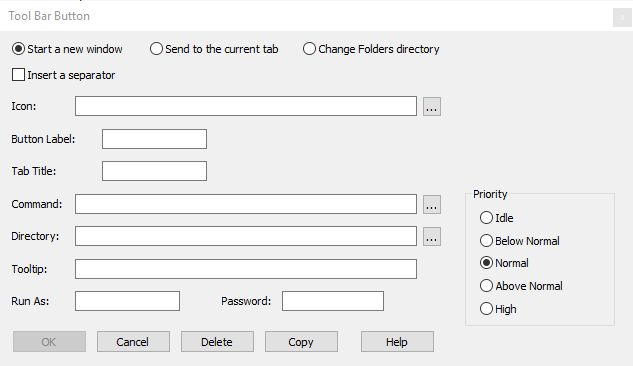The Tabbed Toolbar
Take Command features a user-configurable tabbed toolbar. You can create buttons to launch new instances of TCC or any other console program, send keystrokes to the console pane, or change the location displayed in the List View pane.
|
The tabbed toolbar provides single-click access to programs, locations, and even strings of keystrokes.
|
To use it, you will need to enable it: select View / Toolbars / Menus, and make sure the“Tabbed Toolbar” entry is checked. To define, change or remove buttons, select Options / Configure Tabbed Toolbar... and then click on the button you want to change. To create a new button, click on the first blank one.
There are three different kinds of buttons you can create: a button to start a new console tab, a button which sends keystrokes to the current tab, or a button which changes the directory shown in the List View pane. The first is probably the most common use; it's selected by the“Start a new window” option in the button definition dialog. The Command field specifies the filename of the program to run in the new tab, and optionally any paramaters to pass to it. You can use environment variables in the Command field, %COMSPEC for example. If the program is a command shell like TCC or CMD.EXE, you can use the /K option to run a batch file or other command when it starts. You can specify the program's current directory using the Directory field; if this field empty, the program will usually start in the same directory displayed in the List View window.
A program launched through the button bar does not have to be a shell; you can create a button for any Windows console program. For example, you might want a button to start telnet or your text editor.
To make a button which sends keystrokes to the console pane, choose the“Send to the current tab” option. The Command field holds the keys to send in KEYSTACK format: literal strings in double quotes, keynames not quoted. Type HELP KEYSTACK in TCC for details. Again, you can use environment variables if you like.
The final button type affects the Folders and List View panes, not the console pane. Choose the “Change Folders directory” in the button definition dialog, and type the desired location in the Directory field. Environment variables are legal here too: %userprofile\My Documents or %userprofile\Desktop might be useful. (Quotes are not required for directory names containing spaces.)
|
One use for a button: Changing the location displayed in the Folders and List View panes. Note the use of an environment variable in the definition.
|
Environment variable expansion in the Command and Directory fields is performed by Take Command, which has some interesting repercussions. One is that the specific environment used is the one inherited by Take Command when it started, not the environment of TCC or CMD.EXE or any other program running in a console tab. SETcommands in TCC or CMD.EXE will not change this environment. An intriguing benefit is that you can use many internal variables and even functions; for instance,%_winsysdir and %@path[%_cmdspec] are both legal in the Directory field. Finally, note that a trailing percent sign is not required when the next character is unambiguously not part of the variable name.
If you want to rearrange toolbar buttons, hold down the Alt key and the left mouse button and drag the button to its new location.


